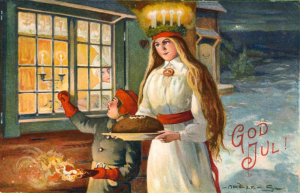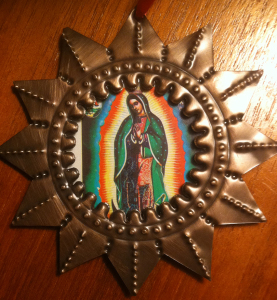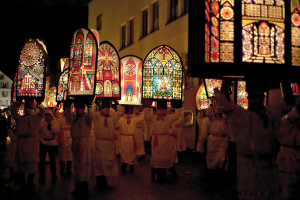Have you ever spent a summer in Maine? I’ve spent many summers there, whether to be with family or, back when I was in graduate school, for a series of letterpress internships I did there in Portland and at the Shaker Community at Sabbathday Lake in New Gloucester. When it is summer in Maine, the days seem to last forever, with the sun rising early and setting late, well past the bedtime hour for many children.
Of course there must be balance to that, and now, as we approach midwinter, it’s quite a different story in Maine, and darkness falls early at this time of year and lingers long. The shift of darkness and light is even more extreme, though, in a place like Sweden, up near the Arctic Circle. The land of the midnight sun is, at this time of year, spending an awful lot of time cloaked in darkness.
Perhaps it is fitting, then, that the people of Sweden would open their arms and hearts to a saint from Sicily whose feast day comes in with the longest nights of the year. She is Santa Lucia, Saint Lucy, another of our wintertime gift bearers. The gifts she bears are simple but just what is needed about now: hot coffee and warm baked goods, heady with the scent of saffron and ginger. And light. Lucia brings light in the darkness. Of course we “see the light” and Lucia is a patron saint of those with maladies of the eyes, for she herself plucked out her own eyeballs in response to the unwelcome advances of a potential suitor. He loved her eyes, they captivated him. And so she put an end to that right then and there. This was under Roman rule in the fourth century and it wasn’t long after the eyeball incident that Lucia was martyred for her Christian faith. And while she plunged herself into darkness in her act of defiance, Lucia the saint became a light bearer.
And it is the Lucia who carries light with her in the early morning darkness, entering the rooms of the household with lussekatter (saffron buns) and coffee. She is usually the oldest girl in the house, and she is usually dressed in white with a red sash, donning a wreath of illuminated candles upon her head. There are processions throughout Sweden celebrating Santa Lucia, in churches, in schools, in city streets, on national television. The processions can get quite large, with scores of attendants to the Lucia, each bearing a candle, and also a large number of “star boys” donning huge white conical caps. Everyone is dressed in white, and the procession always centers around the Neapolitan melody “Santa Lucia,” but with Swedish lyrics, my favorite part being Natten går tunga fjät, which translates to “The night walks with heavy steps.” Such a beautiful image, and such a beautiful song. You can feel it warming the air, you can feel it bearing light in the darkness.
Image: An early 20th century Swedish Christmas penny postcard designed by Adèle Söderberg (1880-1915).


